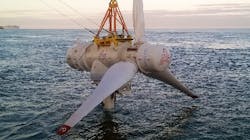Tidal stream energy could dive to record low cost if opportunity is seized
GLASGOW, Scotland — Tidal stream energy could plummet below £80 per MWh by 2035 if current opportunity is realized, according to a report by the Offshore Renewable Energy (ORE) Catapult as part of the Interreg FCE-funded TIGER project.
The report documents the global state of the tidal market, and it presents a cost reduction trajectory taking tidal stream energy from its current price of £260/MWh down to £78/MWh by 2035.
Simon Cheeseman, sector lead for wave and tidal energy with ORE Catapult, said, “This report presents a cost reduction trajectory for the tidal stream energy industry and an effective way to track progress over the next 15 years. It allows technology providers, policymakers and investors to see how the industry has evolved, and how tidal stream can make a significant contribution to energy security in the future. The sector has never been stronger and the rollout of tidal stream energy is a huge opportunity we must capitalize on.”
The report found that drivers for tidal stream energy cost reduction include scaling up the size and power of tidal devices, and development of larger tidal stream energy farms. Moving to piled foundations and anchors for fixed bottom and floating devices respectively would also deliver cost savings. Longer term, the report estimates that a LCOE of £60/MWh could be reached by 2042 and £50/MWh by 2047.
Economic benefits, in recent studies from the University of Edinburgh and University of Manchester, were also highlighted in the report. Tidal stream energy projects generate more than 80% of materials from the local supply chain, create up to 45 jobs per MW deployed—exceeding the wind and solar industries—and could contribute up to £17 billion to the UK economy by 2050. It also highlighted that the UK could capture 25% of the international market value of tidal stream energy through export.
The report suggests that 877 MW of tidal stream energy could be deployed in the UK by 2035, in agreement with the Marine Energy Council’s ask for the UK government to commit to 1 GW of marine energy deployment by 2035.
The report also highlights that tidal stream energy could dramatically improve domestic energy security and reduce costs in the future energy system due to its predictable nature. An increasing emphasis on domestic energy security presents an opportunity for tidal stream energy to build capacity as a reliable and forecastable complementary renewable energy source.
Caroline Lourie, technical manager, at the European Marine Energy Centre (EMEC) said, “The UK remains the most attractive global market for tidal stream energy, with over 10 GW potential. In 2021, £20 million a year was ring-fenced for the sector through the UK government’s Contracts for Difference scheme, an important endorsement of the industry. However, to drive down costs so that tidal energy is competitive with other renewables, a huge ramp up of installed capacity will be needed over the next decade. For this to happen, we need long-term policy support and continued ring-fenced funding.”
The report called on policymakers in the UK and France to support the tidal stream energy cost reduction trajectory by committing to industry deployment targets, ensure tidal stream energy has a secure route to market such as ring-fenced funding in the UK government’s Contracts for Difference rounds, and streamline the consenting process to strengthen the project pipeline. These three actions will improve private sector confidence, open new tidal stream energy funding streams and accelerate the cost reduction process, according to the report.
10.18.2022



